Abstract
Poor compliance with appointments and drug treatment is one of the recognised factors preventing effective management of hypertension. Factors predictive of poor attendance and inadequate blood pressure control in patients attending a hypertension clinic were therefore determined using univariate analyses and a multivariate logistic model. Out of 1346 patients with blood pressure exceeding 160/95 mm Hg followed up for three years, 209 (15.5%) dropped out during the first year. Variables that were significantly related to increased drop out rates were male sex, young age, obesity at entry, cigarette smoking, direct referral to the clinic as a result of screening instead of referral by a general practitioner, absence of pre-existing antihypertensive treatment at the first visit, moderate hypertension, and low socioeconomic category. Variables at entry that were significantly related to poor blood pressure control at one year were old age, evidence of coronary heart disease, severe hypertension, and raised blood glucose concentrations. Early detection of patients at high risk of drop out or poor blood pressure control might improve treatment of hypertension and allow management to be more individually adapted to each patient.
Full text
PDF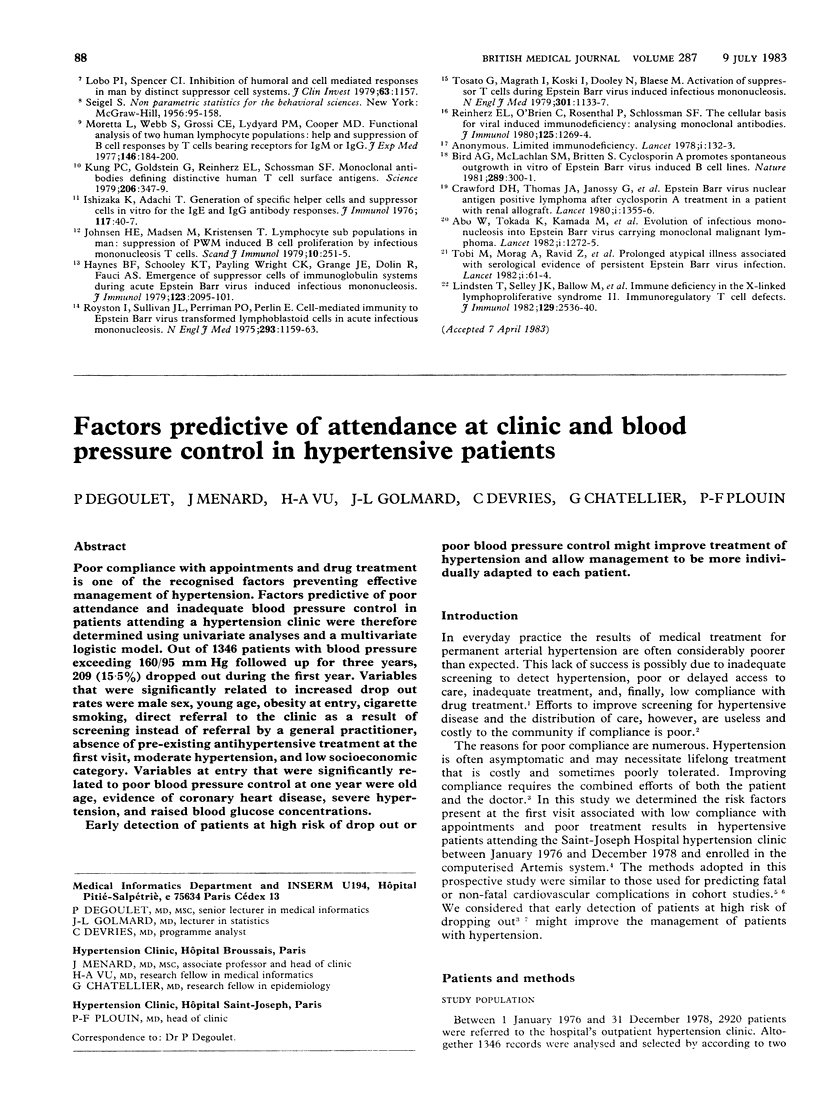
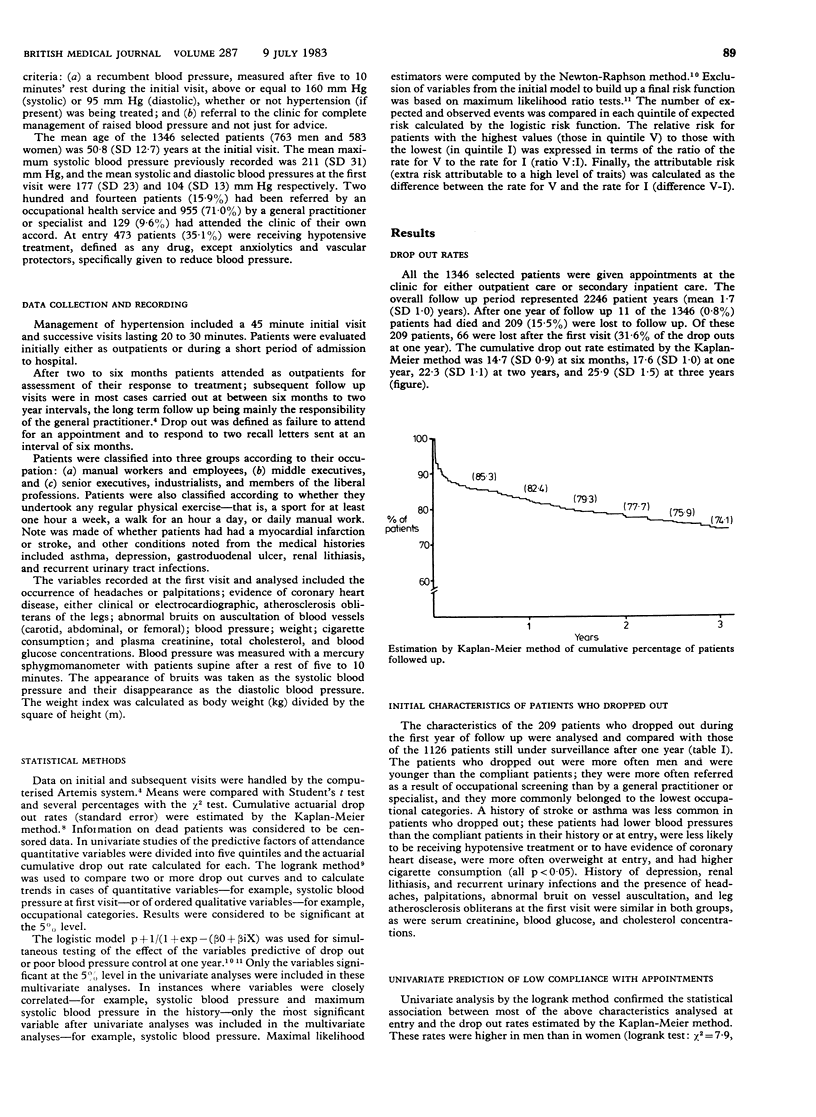
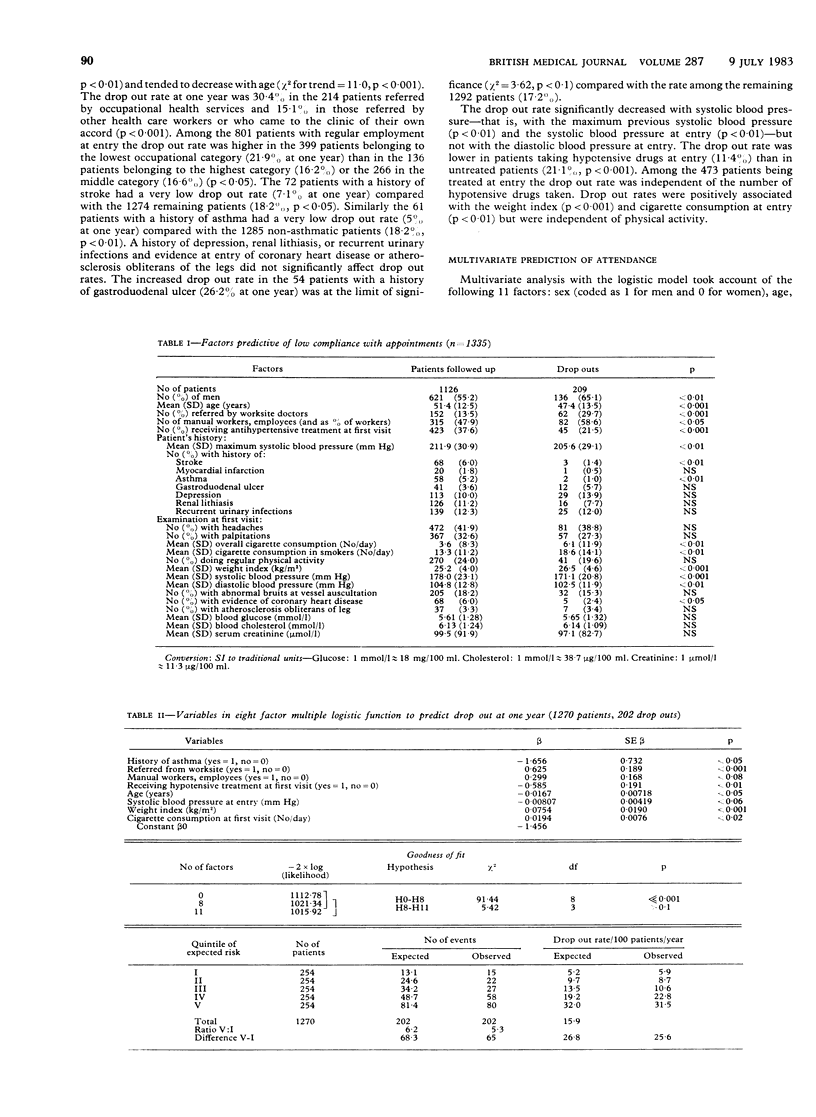
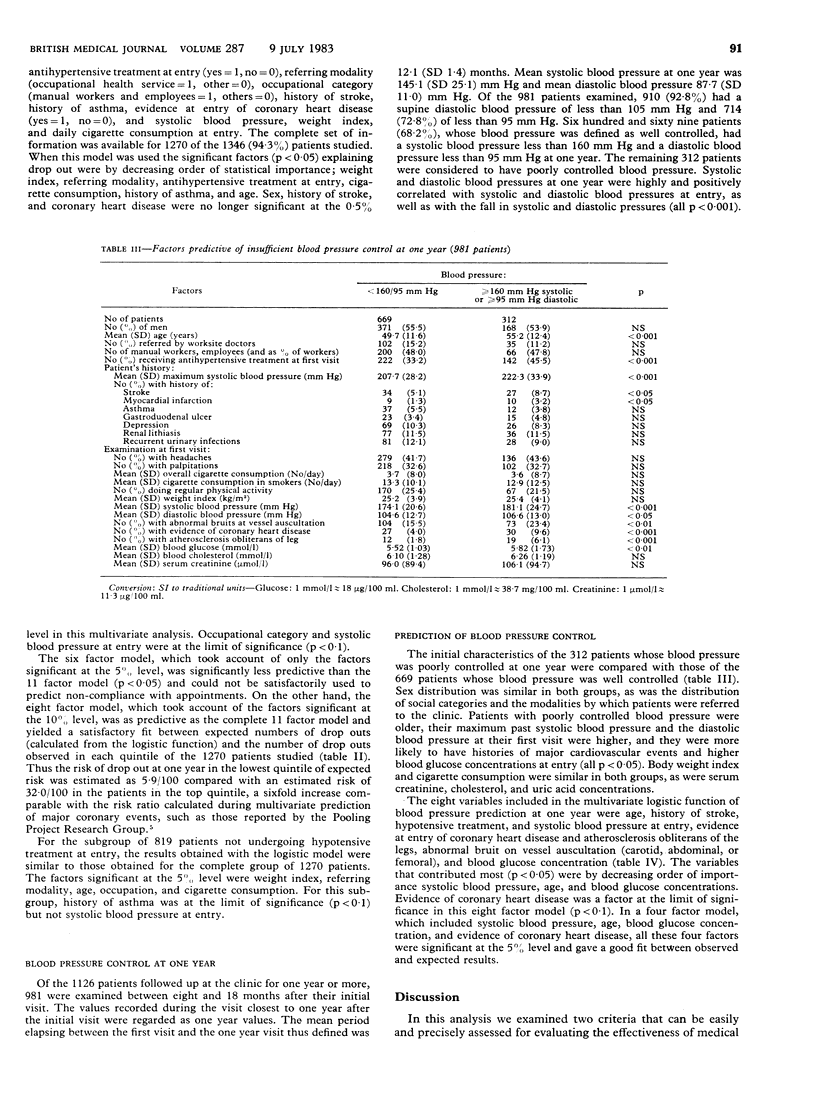

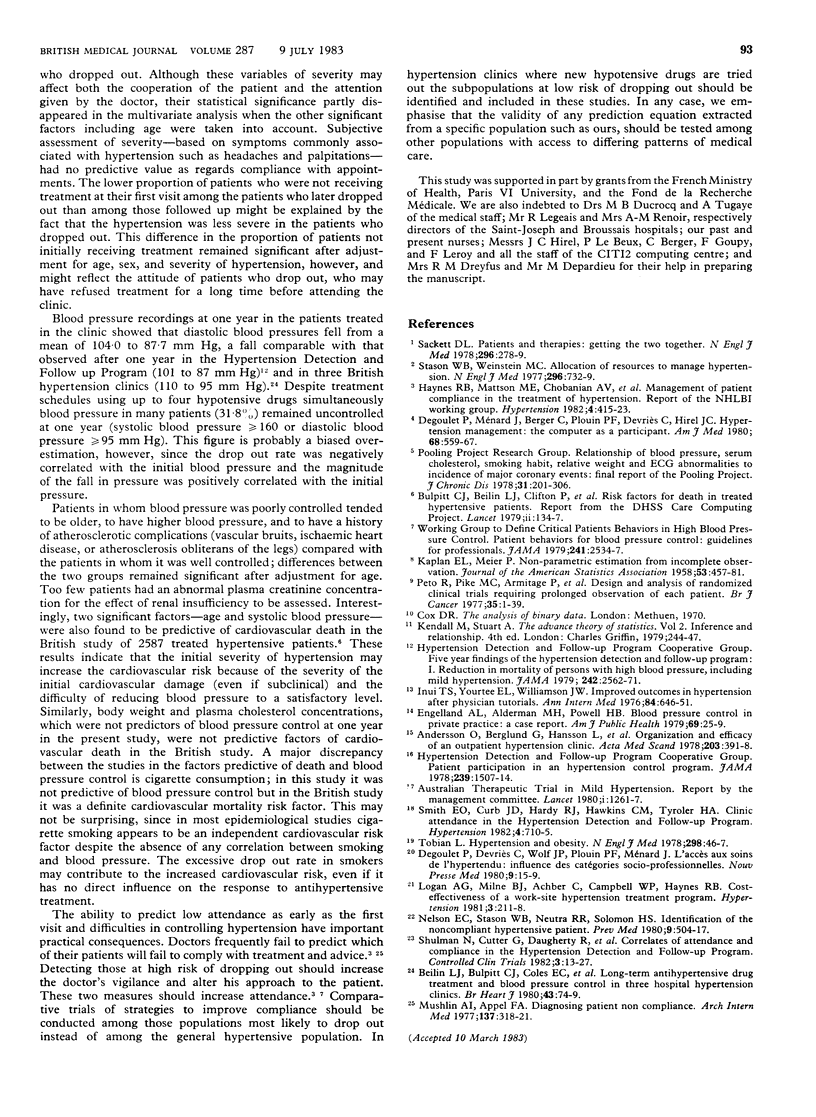
Selected References
These references are in PubMed. This may not be the complete list of references from this article.
- Anderson O., Berglund G., Hansson L., Sannerstedt R., Sivertsson R., Wikstrand J., Wilhelmsen L. Organization and efficacy of an out-patient hypertension clinic. Acta Med Scand. 1978;203(5):391–398. doi: 10.1111/j.0954-6820.1978.tb14894.x. [DOI] [PubMed] [Google Scholar]
- Beilin L. J., Bulpitt C. J., Coles E. C., Dollery C. T., Gear J. S., Harper G., Johnson B. F., Munro-Faure A. D., Turner S. C. Long-term antihypertensive drug treatment and blood pressure control in three hospital hypertension clinics. Br Heart J. 1980 Jan;43(1):74–79. doi: 10.1136/hrt.43.1.74. [DOI] [PMC free article] [PubMed] [Google Scholar]
- Bulpitt C. J., Beilin L. J., Clifton P., Coles E. C., Dollery C. T., Gear J. S., Harper G. S., Johnson B. F., Munro-Faure A. D. Risk factors for death in treated hypertensive patients. Report from the D.H.S.S. Hypertension Care Computing Project. Lancet. 1979 Jul 21;2(8134):134–137. doi: 10.1016/s0140-6736(79)90013-8. [DOI] [PubMed] [Google Scholar]
- Degoulet P., Devries C., Wolf J. P., Plouin P. F., Menard J. L'accès de l'hypertendu aux soins: influence des catégories socio-professionnelles. Nouv Presse Med. 1980 Jan 5;9(1):15–19. [PubMed] [Google Scholar]
- Degoulet P., Menard J., Berger C., Plouin P. F., Devries C., Hirel J. C. Hypertension management: the computer as a participant. Am J Med. 1980 Apr;68(4):559–567. doi: 10.1016/0002-9343(80)90306-x. [DOI] [PubMed] [Google Scholar]
- Engelland A. L., Alderman M. H., Powell H. B. Blood pressure control in private practice: a case report. Am J Public Health. 1979 Jan;69(1):25–29. doi: 10.2105/ajph.69.1.25. [DOI] [PMC free article] [PubMed] [Google Scholar]
- Inui T. S., Yourtee E. L., Williamson J. W. Improved outcomes in hypertension after physician tutorials. A controlled trial. Ann Intern Med. 1976 Jun;84(6):646–651. doi: 10.7326/0003-4819-84-6-646. [DOI] [PubMed] [Google Scholar]
- Logan A. G., Milne B. J., Achber C., Campbell W. P., Haynes R. B. Cost-effectiveness of a worksite hypertension treatment program. Hypertension. 1981 Mar-Apr;3(2):211–218. doi: 10.1161/01.hyp.3.2.211. [DOI] [PubMed] [Google Scholar]
- Management of patient compliance in the treatment of hypertension. Report of the NHLBI Working Group. Hypertension. 1982 May-Jun;4(3):415–423. doi: 10.1161/01.hyp.4.3.415. [DOI] [PubMed] [Google Scholar]
- Mushlin A. I., Appel F. A. Diagnosing potential noncompliance. Physicians' ability in a behavioral dimension of medical care. Arch Intern Med. 1977 Mar;137(3):318–321. doi: 10.1001/archinte.137.3.318. [DOI] [PubMed] [Google Scholar]
- Nelson E. C., Stason W. B., Neutra R. R., Solomon H. S. Identification of the noncompliant hypertensive patient. Prev Med. 1980 Jul;9(4):504–517. doi: 10.1016/0091-7435(80)90045-6. [DOI] [PubMed] [Google Scholar]
- Peto R., Pike M. C., Armitage P., Breslow N. E., Cox D. R., Howard S. V., Mantel N., McPherson K., Peto J., Smith P. G. Design and analysis of randomized clinical trials requiring prolonged observation of each patient. II. analysis and examples. Br J Cancer. 1977 Jan;35(1):1–39. doi: 10.1038/bjc.1977.1. [DOI] [PMC free article] [PubMed] [Google Scholar]
- Shulman N., Cutter G., Daugherty R., Sexton M., Pauk G., Taylor M. J., Tyler M. Correlates of attendance and compliance in the hypertension detection and follow-up program. Control Clin Trials. 1982 Mar;3(1):13–27. doi: 10.1016/0197-2456(82)90016-2. [DOI] [PubMed] [Google Scholar]
- Smith E. O., Curb J. D., Hardy R. J., Hawkins C. M., Tyroler H. A. Clinic attendance in the hypertension detection and follow-up program. Hypertension. 1982 Sep-Oct;4(5):710–715. doi: 10.1161/01.hyp.4.5.710. [DOI] [PubMed] [Google Scholar]
- Stason W. B., Weinstein M. C. Public-health rounds at the Harvard School of Public Health. Allocation of resources to manage hypertension. N Engl J Med. 1977 Mar 31;296(13):732–739. doi: 10.1056/NEJM197703312961307. [DOI] [PubMed] [Google Scholar]
- Tobian L. Hypertension and obesity. N Engl J Med. 1978 Jan 5;298(1):46–48. doi: 10.1056/NEJM197801052980110. [DOI] [PubMed] [Google Scholar]


